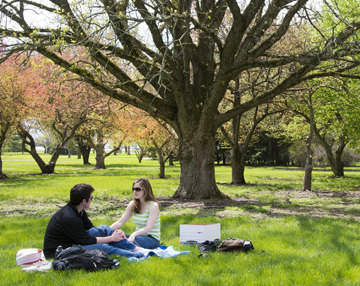Did You Know?: Horticulture Park
May 1, 2013
 |
|
Douglas
Booth and Kelsey Houin have a picnic in Horticulture Park. The two are planning
a wedding at the park in June. (Purdue University photo/Mark Simons)
|
Home to more than 300 types of trees and plants, Horticulture Park provides a nearby escape from Purdue's campus, as well as academic experiences for horticulture and forestry classes.
Located on State Road 26 just west of McCormick Road, the 24-acre park officially opened May 10, 1967. C.W. Beese, professor of engineering and a plant enthusiast, donated the park's central parcel of land. Beese originally started the park's plant collection in the 1940s. Other portions of the park come from the estate of R.B. Stewart, and the neighboring Wabash Valley Nursery.
Though the park's central area is a maintained landscape, it feathers back into a natural wooded area. Mulched walking trails snake throughout the park and are accessible from parking lots off of McCormick Road and State Road 26.
The Grounds Department cares for the park. Scott Helmkamp, grounds and landscape supervisor, oversees the efforts to care for and maintain the park. Maintenance includes mowing, pruning trees, fertilizing, controlling weeds and cleaning up after guests.
The park is open during daylight hours for recreational walking and biking, and it is frequently used for group picnics. It is also used academically for forestry and horticulture identification classes. A large portion of Purdue's horticulture and forestry collections are housed in the park, and students are tasked to distinguish different types by sight, even during the bare winter months.
"Such a beautiful area that's used for academics and the general public and is so close to campus is an excellent asset to Purdue," Helmkamp says. "It's a quiet getaway from the rest of campus that is just minutes away."
Although it is a popular location, Ted Sharp, equipment operator and dubbed the unofficial park curator, says the grounds are easy to maintain.
"Considering the amount of guests that I see take advantage of the park, there isn't much litter or mess to pick up," Sharp says. "The people who come out and enjoy it are also very conscious about caring for the park and keeping it in a healthy condition."
Sharp, who studied forestry at Purdue, has a connection to Horticulture Park beyond his academic and career experiences. He and his wife, a Purdue horticulture alumna, were married underneath the park's spruce trees 30 years ago.
As part of Purdue's sustainability efforts, Sharp and Helmkamp work to keep the park as "green" as possible. An integrated pest management system, which manages problems in as economically and environmentally friendly a way as possible, is used and problems are spot-treated, as opposed to mass treatment.
"We try to look for every alternative possible before we look to pesticides," Helmkamp says. "And when we do, we try to use natural products as much as possible."
To reduce waste and bring more variety to Horticulture Park, Sharp takes plants displaced by campus construction and replants them in the park. He recently spent time finding the right location to replant a set of rhododendrons, a plant that can be difficult to move. The rhododendrons had been on campus when Sharp attended Purdue 30 years ago.
"When we reuse plants in this way, we enhance Horticulture Park and contribute to Purdue’s sustainability," Helmkamp says. "Sometimes, we're also saving a bit of history."
Writer: Rachel Florman, rflorman@purdue.edu
